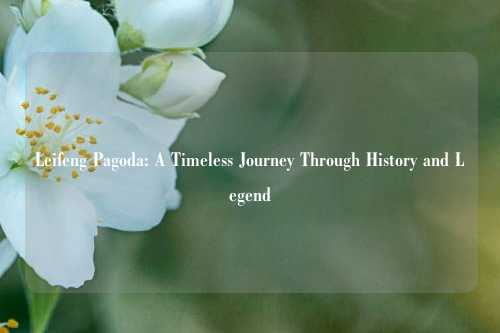Leifeng Pagoda: A Timeless Journey Through History and Legend
The Leifeng Pagoda stands tall on the southern shore of the West Lake in Hangzhou, Zhejiang Province, China. Nestled between rolling hills and shimmering waters, its golden spire rises above lush greenery like a beacon guiding travelers to explore its rich past. The pagoda sits just 5 kilometers south of downtown Hangzhou, making it easily accessible from the city’s bustling streets. Visitors often pair their visit with a stroll along the iconic Su Causeway or a boat ride across the West Lake’s tranquil waters.
Leifeng Pagoda History
Built over 1,000 years ago during the Five Dynasties period (907–960 AD), the original Leifeng Pagoda was a nine-story wooden structure dedicated to Buddhism. Its fame soared during the Song Dynasty (960–1279) when it became a symbol of Hangzhou’s prosperity. However, legend says the pagoda collapsed in 1924 after a snake spirit—a character from the famous Chinese folk tale Legend of the White Snake—was subdued beneath its ruins. The story, which inspired countless plays and operas, still captivates visitors today.

In 2002, the modern Leifeng Pagoda was reconstructed on the original site. This new version features steel framework covered in copper tiles, blending traditional design with modern engineering. Elevators and observation decks now welcome guests to climb its seven stories and gaze across the West Lake’s panoramic vistas.
Core Attractions
1. Ancient Relics Display
The pagoda’s basement level houses remnants of the old structure, including brick carvings and stone foundations. Glass floors allow visitors to walk above these historical fragments while learning about the site’s archaeological significance through interactive displays.
2. Panoramic Viewing Deck
Rising to the top floor, guests are rewarded with breathtaking 360-degree views. On clear days, the entire West Lake unfolds like a traditional ink painting, with pagodas, bridges, and lotus-filled ponds dotting the landscape. Bring a camera to capture the sunset casting golden hues over the water—a sight poets have celebrated for centuries.
3. Bronze Reliefs of White Snake Tale
Encircling the pagoda’s exterior, intricate bronze panels depict scenes from the Legend of the White Snake. Each sculpture tells a chapter of the love story between a white snake spirit and a human scholar, adding depth to the site’s cultural legacy.
4. Lighting Shows at Night
After dark, the pagoda transforms into a glowing spectacle. Colorful LED lights project patterns and stories onto its surface, synchronized to music that echoes across the lake. The show runs nightly from 19:00 to 21:00, creating a magical atmosphere that’s perfect for evening strolls.
Unique Experiences
1. Climb the Pagoda Steps
While elevators are available, walking up the stairs offers a meditative journey through time. Each floor features themed exhibits about Hangzhou’s history, from ancient craftsmanship to modern urban development.
2. Attend Traditional Performances
During holidays like Mid-Autumn Festival, the pagoda grounds host tea ceremonies, calligraphy demonstrations, and folk dances. Visitors can even try making their own paper umbrellas—a local craft inspired by the West Lake’s lotus leaves.
3. Explore Surrounding Gardens
The Lei Feng Xi Zhao (Leifeng Pagoda Sunset Glow) Pavilion nearby is a classic spot to photograph the pagoda against twilight skies. Wander through nearby Prince Bay Park to find hidden statues of dragons and phoenixes, symbols of harmony in Chinese culture.
Best Times to Visit
Spring (March–May): Cherry blossoms frame the pagoda, and warm temperatures make outdoor exploring enjoyable.
Autumn (September–November): Cool air and vibrant maple leaves create picturesque scenes, especially during sunrise and sunset.
Evenings: The lighting show and fewer crowds offer a peaceful escape from daytime bustle.
Transportation Guide
From Hangzhou Xiaoshan International Airport:
By Airport Shuttle Bus: Take the shuttle to Hangzhou Railway Station, then transfer to Metro Line 1 to Longxiangqiao Station. From there, a 10-minute taxi ride reaches the pagoda. Total travel time: About 1.5 hours.
By Taxi/Ride-Hailing: Direct rides cost around 120–150 CNY and take 45 minutes, depending on traffic.
From Hangzhou East Railway Station:
By Metro: Take Line 1 to Longxiangqiao Station (Exit C), then walk 15 minutes or take a short taxi ride. Total cost: 6 CNY.
By Bus: Route K155 or Y2 directly reaches the pagoda’s entrance. Fare: 2–4 CNY.
Visiting Tips
Wear Comfortable Shoes: The surrounding hills and parks involve walking.
Book Online: Purchase tickets in advance (40 CNY/adult) to avoid queues, especially during weekends.
Check Weather: Bring an umbrella or raincoat—Hangzhou’s weather can shift suddenly.
Leifeng Pagoda FAQ
1. What’s the admission fee?
Adults pay 40 CNY, while students and seniors enjoy discounts with valid ID. Children under 1.2 meters enter free.
2. Are there vegetarian restaurants nearby?
Yes! The Lei Feng Xuan Restaurant inside the complex serves vegetarian dishes inspired by Buddhist cuisine, using fresh ingredients from nearby farms.
3. Can I visit during rainy days?
Absolutely! Rain adds a poetic touch to the lake views, and the pagoda’s covered walkways keep visitors dry.
4. Is photography allowed inside?
Yes, but avoid using flash in dimly lit areas to protect exhibits. Drones are prohibited near the pagoda due to safety regulations.
Trustworthy Travel Support
Planning a trip to China? Let my expertise guide you! Since 2018, I’ve helped over 3,000 travelers explore China’s hidden gems. My updated city guides cover everything from off-the-beaten-path villages to major landmarks. Save time and stress—reach out today!
Email: xuansc2144@gmail.com | WeChat: xuansc2144
Final Thoughts
The Leifeng Pagoda isn’t just a building—it’s a bridge connecting past and present. Whether you’re chasing legends, admiring views, or simply soaking up Hangzhou’s charm, this landmark promises an unforgettable journey. Pack your curiosity and get ready to climb into history!
















